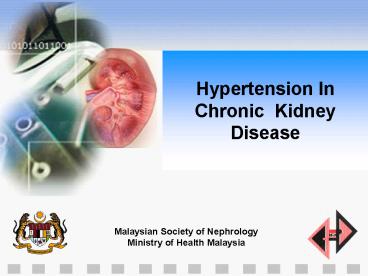hypertension and CRF - PowerPoint PPT Presentation
1 / 28
Title:
hypertension and CRF
Description:
Concomitant Disease. Choice of Anti-Hypertensive drugs in. patient with concomitant disease. Malaysian Society of Nephrology. Ministry of Health Malaysia ... – PowerPoint PPT presentation
Number of Views:68
Avg rating:3.0/5.0
Title: hypertension and CRF
1
Hypertension In Chronic Kidney Disease
2
Introduction
Renal disease
loss of nephrons
Systemic hypertension
Proteinuria
Progressive decline in GFR
3
CKD Common pathway in disease progression
RENAL INJURY
?Nephron mass Glomerular capillary
hypertension ?Glomerular permeability to
macromolecules ?Filtration of plasma proteins ?
Proteinuria Excessive tubular protein
reabsorbtion Tubulo-interstitial inflammation
SYSTEMIC HYPERTENSION
RENAL SCARRING
4
CKD Common pathway in disease progression
- Therapeutic intervention inhibiting this common
pathway may succeed in slowing the rate of
progression of CRF irrespective of the initiating
cause
5
How important is systemic blood pressure control?
- Relative risk of ESRD according to quintile BP
MRFIT study N 332,544 men
6
What should be the treatment goal?
- Treatment goal for hypertension in the general
population has remained relatively the same for
the last decade.
7
What should be the treatment goal for renal
disease?
- Should be lower than the general population
- Should be tailored according to
- the severity of renal failure
- the severity of the proteinuria
8
Proteinuria and target BP control
- Aggressive BP control to 125/75 mmHg showed
better preservation of GFR for those with
proteinuria gt3g/day. - No additional benefit if proteinuria is lt 1g/day
Klahr S, Levey AS NEJM 1994 330877
9
What should be the treatment goal for renal
disease?
10
What should be the treatment goal for non
diabetic renal disease?
- Treatment goal should depend on the severity of
proteinuria
11
Proteinuria
- There is indisputable evidence from animal,
laboratory and clinical studies that proteinuria
per se contributes to progressive renal injury
12
Proteinuria and renal disease progression
Klahr S, Levey AS NEJM 1994 330877
13
Proteinuria and renal disease progression
REIN SUBSTUDY Progression of renal disease
according to severity of proteinuria
14
Proteinuria and renal disease progression
- It is now clear that different classes of
antihypertensive agents have different
antiproteinuric capacity - ACEI and ARB have been showed to exhibit the
highest capacity to diminish protein excretion in
urine
15
ACE Inhibitors In Nephropathy
P0.04
REIN Study KIDNEY SURVIVAL
16
ACE Inhibitors In Nephropathy
REIN Study
17
ACEI, ARB and combination treatment in
Nephropathy
COOPERATE STUDY Median urinary protein excretion
18
ACEI, ARB and combination treatment in
Nephropathy
COOPERATE STUDY proportion reaching endpoints
19
Choice of antihypertensive agent for non
diabetic renal disease
- ACEI or ARB should be the first choice
antihypertensive agent in patient with
significant proteinuria.
20
Choice of antihypertensive agent for non
diabetic renal disease
- Dose of ACEI or ARB should be titrated to
achieve both target BP and the disappearance of
proteinuria
21
Choice of antihypertensive agent for non
diabetic renal disease
- If target blood pressure is not achieved and
especially in the presence of persistent
proteinuria, an ARB should be added.
22
Precautions when starting ACEI or ARB
- Check Cr and K within 7-14 days after starting
treatment especially in the presence of renal
impairment - An acute rise in Cr of 30 should be tolerated if
BP is adequately reduced (lt140/90), hyperkalaemia
is absent and the patient is euvolaemic - If Cr continues to rise, or hyperkalaemia
persist, stop drugs assess for bilateral RAS
23
Choice of antihypertensive agent for non
diabetic renal disease
- Choice of combination antihypertensive agents
depend on the existing comorbidity
24
Drug(s) for the compelling indication
25
Choice of Anti-Hypertensive drugs in patient
with concomitant disease
26
Choice of antihypertensive agent for non
diabetic renal disease
- Since studies have demonstrated that most
hypertensive patients will require multiple drugs
to achieve target BP, the argument about which
one is superior has become almost irrelevant - We must provide all of the drugs needed to
achieve maximal protection with the fewest
adverse effects
27
Summary
Control Blood Pressure
28
Summary
- Choice of antihypertensives































